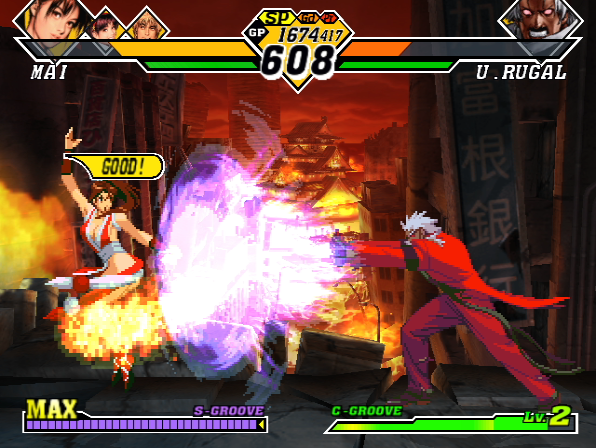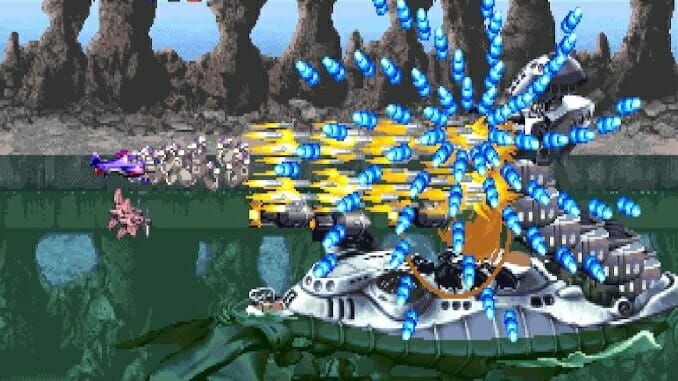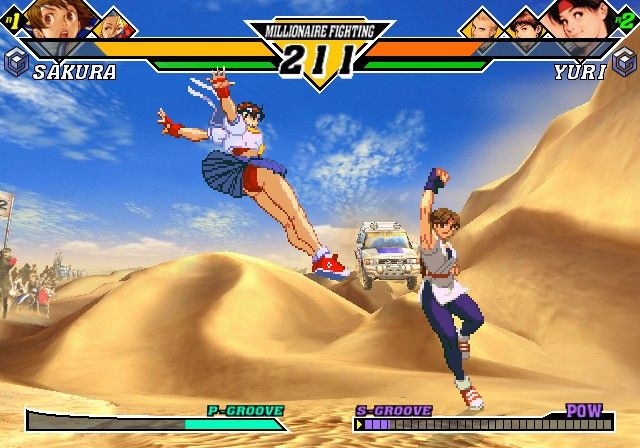If 2000 marked the sharp decline of Capcom and SNK’s arcade
days, 2001 practically marked the end of it, or at least the near-end because
there’s more years to go. SNK officially
went bankrupt and was bought out by the South Korean company Eolith while Capcom
put even more focus on console games, which worked out well considering they
made Devil May Cry.
It makes sense that arcade gaming would be on the decline. I guess rising manpower requirement played a
hand in it, but part of what made most of these arcade games so amazing when
they came out was that they were on hardware much more powerful than what was
available on home consoles and most ports of them were imperfect. 2001 was the year of the Xbox, Gamecube and
PS2, and the Dreamcast was already on the scene. All of them were not only capable of running
both company’s latest and greatest games, but enhanced versions of them, which
was a good thing for them to take advantage of, and I’m sure as hell happy with
my PS2 copies of KOF 2000 & 2003, but it also showed that arcades no longer
had quite the appeal they used to.
That doesn’t mean it was all over. Through all the odds SNK was still able to
make another yearly addition to The King of Fighters and Capcom made another
game to throw down with SNK for cross-company grudge matches. With two games from each company, both have
an equal opportunity to win 2001! Who
will it be?!
Progrear(CAP): This is a different circle of bullet hell
than Giga Wing. Instead of being
bombarded by what can be described as constant clouds of enemy lazer fire,
there’s a duality approach to how Progear does things.
The player ship, of which there are two selectable
components, have the usual spread shot bombardment while it navigates the
screen full of instant death shots, but unlike other shooters, holding down the
fire button doesn’t charge a shot, but instead concentrates fire in a straight
line, allowing for focused, high-damage assaults that add a layer of forward thinking to the
moment-to-moment gameplay.
The enemies have a similar dynamic, where their attacks come
in waves of indiscriminate fire and clouds of targeted fire that keep the
player from staying in one spot and only occasionally dodging like you see
players do in a lot of other bullet hell games.
Compared to those other bullet hell games, Progear is on the
easier side. It’s still a really
difficult game you’ll die a lot in, but like Giga Wing there’s a deflector
shield in the form of bombs for a lifeline.
Attack patterns are also slow enough to map out what areas are safe
without being blindsided and the player ships have surprisingly generous
hitboxes. I swear you have to be hit
dead center to die. Progear is a good
game to start trying out the bullet hell genre with if the more notorious ones
look a little too intimidating, but you’re still going to be using a lot of
continues.
Enemy variety is low and some can take considerable
punishment, which can lead to slow pacing, not helped by times where the game
drags on and won’t stop throwing enemies at the player, particularly in the
final level preceding a very annoying and frustrating final boss. It takes about an hour to beat the game, but
unlike Metal Slug 3, which has a similar play time, Sengoku 3 doesn’t switch
things up consistently enough to justify it.
Compared to all the beat-em-ups I’ve played for this series,
Sengoku 3 is above the likes of Knights of the Round, Warriors of Fate and
Mutation Nation, but definitely below Captain Commando and Battle Circuit,
putting it in the respectable “ok” rating range.
Capcom vs. SNK 2(CAP)
After SNK’s take on a crossover with the Neogeo Pocket Color’s
SNK vs. Capcom, Capcom took 2 shots at their adversaries with the duology of
Capcom vs. SNK. The first one only had a
good port on the Dreamcast and a bad one on the PS1, but Capcom vs. SNK 2 had
some great ports to the PS2, Xbox and Gamecube.
The groove system is an ingenious way to put the gameplay of
these different games in one crossover, but it does have the inevitability of
imbalance. One of the most infamous groove-specific
tricks is roll canceling, where characters can perform moves out of a KOF dodge
roll without consequence. Great for
cheesing bosses, but not fair to use against other players. Thankfully the “EO” console releases of the
games fixed it. The KOF 94 & 95
groove also brought back the ability to spam super attacks when the player’s
health is low and there’s a reason the updated version of KOF 98 put an end to
that.
Maybe it could’ve used some tweaking, but Capcom vs. SNK 2 really
has it all. It has fast-paced gameplay
that’s something of a mix of turbo speed in Street Fighter and normal KOF speed
so it satisfies both parties, new Capcom-style sprites for the SNK characters,
special character intros, 3D backgrounds filled with cameos and a memorable, pumpin’
soundtrack. I’ve yet to see a game with
the kind of visual and audio dynamic seen in Capcom vs SNK 2.
 |
| Capcom AND SNK players have their hardest bosses get stronger. |
I’ve played this game for over a decade and it’s still one
of the greatest fighting games of all time I always go back to and never ever
get sick of. This absolute masterpiece
is the game of the year hands down. I
hope I’m right in believing that Capcom is getting ready to put out a re-release
of the duology for modern systems,
The King of Fighters 2001(SNK)
Compared to the previous entries in this amazing series, KOF
2001 is rough and apparently had a rushed development because of everything
happening with SNK’s new ownership. A
lot of what made the previous games stand out are pared back.
Backgrounds have washed-out colors and short, looping
animations, as opposed to the memorable stages with lots of detail and depth
from KOF 99 and 2000, the music is mostly synthesized techno beat crap and all
the unique strikers from 2000 are gone.
2001 has a system where you can have more team members as strikers in
exchange for a higher max super meter and more health, but it’s unbalanced
because you objectively get more health from the end of a round when you have 1
or 2 characters be playable. It was an
interesting idea, but I don’t think it was thought through.
This is also the game where famed artist Shinkiro left SNK
and in his place was Nona, whose weirdly proportioned artwork I never liked in
KOF and some of it has even led to a few memes.
Ending artwork looks downright amateurish, even compared to the
cutscenes used for the bosses in the same game.
 |
| The art feels rushed. The GAME feels rushed. |
The gameplay is at least as good as it should be. It’s still better than the first 2 KOF games
in that it’s playable, but there’s something about it that feels looser than
usual and there are some who even treat it as a kusoge, finding infinites,
abusing the multiple strikers and taking advantage of some weird hitboxes to do
wack shit.
I can’t even say the story is worth it. It does conclude the NESTS saga, but even for
someone like me who follows the plot, what exactly is going on in this game is
vague and very poorly conveyed. Future
games don’t even follow up on the plot besides allusions and basic
acknowledgements of NESTS downfall, but characters introduced here do get some
character development later and are welcome additions to the KOF stable, so it
at least has that.




No comments:
Post a Comment